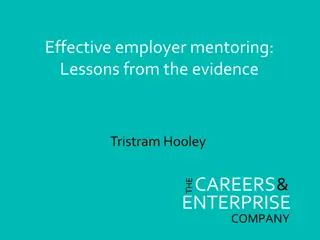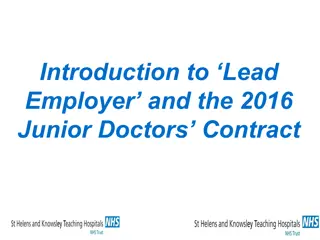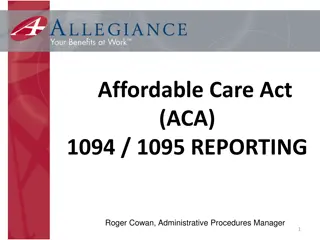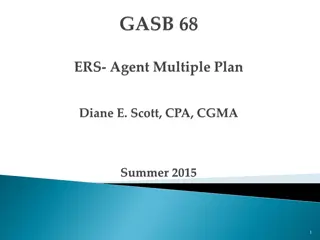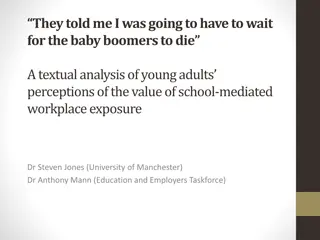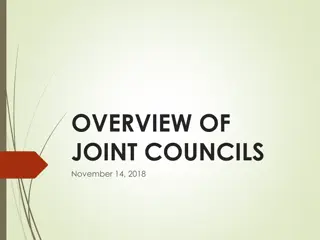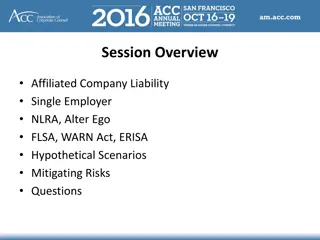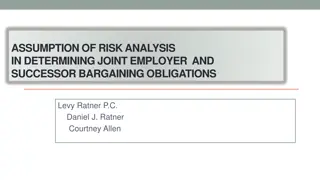Subcontracting & Joint Employer Considerations
Explore the implications of subcontracting and joint employer relationships, including the basics of independent contractors and employees, consequences of joint liability, practical considerations, and the shifting legal landscape surrounding joint employment. Learn about key legal principles and the importance of understanding the status of independent contractors. Stay informed about recent legal developments that affect liability for subcontracted or temporary workers.
Download Presentation

Please find below an Image/Link to download the presentation.
The content on the website is provided AS IS for your information and personal use only. It may not be sold, licensed, or shared on other websites without obtaining consent from the author.If you encounter any issues during the download, it is possible that the publisher has removed the file from their server.
You are allowed to download the files provided on this website for personal or commercial use, subject to the condition that they are used lawfully. All files are the property of their respective owners.
The content on the website is provided AS IS for your information and personal use only. It may not be sold, licensed, or shared on other websites without obtaining consent from the author.
E N D
Presentation Transcript
WHOSE EMPLOYEE IS IT? WHOSE EMPLOYEE IS IT? Subcontracting & Joint Employer Considerations Heather Ren e Adams & Patrick Devine Ice Miller LLP 250 West St., Ste. 700 Columbus, Ohio 43215
AGENDA AGENDA 1. Independent Contractors, Employees, Joint Employers Oh, My! The Basics Why you should care Shifting Legal Landscape 2. Consequences of the Joint Liability Doctrine 3. Practical Considerations 4. Understanding DBE Relationships 5. Joint Employment Implications
THE BASICS THE BASICS 1. Independent Contractors: Independent of substantial control and direction. 2. Employees: Companies have the right to direct and control the manner in which employees perform their jobs. 3. Joint Employer Doctrine: The joint employment exists when the facts establish that employment by one employer is not completely disassociated from employment by the other employer. See Fair Labor Standards Act. Whether multiple employers should be treated as one.
THE BASICS THE BASICS KEY LEGAL PRINCIPLE KEY LEGAL PRINCIPLE A party is liable for its conduct toward its employees but is NOT liable for its conduct toward independent contractors
INDEPENDENT CONTRACTOR STATUS INDEPENDENT CONTRACTOR STATUS WHY YOU CARE WHY YOU CARE Tax Liability Legal Liability o Common law o State law o Federal law Trap: Joint Employment
SHIFTING LEGAL LANDSCAPE: SHIFTING LEGAL LANDSCAPE: Browning-Ferris Industries (August 27, 2015) Decision broadened liability for companies that subcontract, outsource or use temp workers. A prime contractor can be found to be the joint employer of its subcontractor s employees if it is found to exercise direct or indirect control over the subcontractor s employees.
SHIFTING SHIFTING LEGAL Labor Department Rescinds Expanded 'Joint Employer' Rule LEGAL LANDSCAPE LANDSCAPE: : NEWS NEWS RELEASE RELEASE Date: June 7, 2017 Release Number: 17-0807-NAT US US Secretary Secretary of of Labor WASHINGTON WASHINGTON U U. .S S. . Secretary Labor s Labor s 2015 2015 and and 2016 administrator interpretations does not change the legal responsibilities of employers under the Fair Labor Standards Act and the Migrant and Seasonal Agricultural Worker Protection Act, as reflected in the department s long-standing regulations and case law. The department will continue to fully and fairly enforce all laws within its jurisdiction, including the Fair Labor Standards Act and the Migrant and Seasonal Agricultural Worker Protection Act. Labor withdraws withdraws joint Secretary of of Labor 2016 informal informal guidance joint employment, employment, independent Labor Alexander Alexander Acosta guidance on on joint independent contractor Acosta today today announced joint employment employment and contractor informal announced the and independent independent contractors informal guidance guidance the withdrawal withdrawal of of the the U U. .S S. . Department Department of of contractors. Removal of the
CONSEQUENCES OF JOINT EMPLOYER DOCTRINE: CONSEQUENCES OF JOINT EMPLOYER DOCTRINE: Does the Law Apply? Nehls v. Quad-K. Advertising, Inc., 106 Ohio App. 3d 489 (6th Cir. 1995) Secretary of company sued company for sexual harassment and discrimination. Company argues law does not apply because it does not employ workers, rather it uses independent contractors. Court disagrees. The independent contractors are actually employees.
CONSEQUENCES OF JOINT EMPLOYER DOCTRINE: CONSEQUENCES OF JOINT EMPLOYER DOCTRINE: Identifying the Responsible Employer Salinas v. Commercial Interiors, Inc., 848 F.3d 125 (4th Cir. 2017) Mario Salinas employed by subcontractor J.I. General Contractors (framing and drywall) Mario worked almost exclusively for Commercial Interiors, Inc. This company offered general contracting and interior finishing services, including drywall installation, carpentry framing and hardware installation. Mario alleged that he was not paid overtime in violation of the FLSA Mario sought to hold both JI and Commercial liable of the aggregate number of hours he worked for both employers.
CONSEQUENCES OF JOINT EMPLOYER DOCTRINE: CONSEQUENCES OF JOINT EMPLOYER DOCTRINE: Identifying the Responsible Employer JI General Contractors (SUBCONTRACTOR) Commercial Interiors, Inc. (PRIME) Salinas v. Commercial Interiors, Inc., 848 F.3d 125 (4th Cir. 2017) Did not maintain any timesheets for JI employees Factors in favor of joint employer status Factors in favor of joint employer status Mario almost exclusively assigned to work for Commercial Foreman threatened to fire JI employees Required several JI employees complete employment applications in order to work on a Commercial job site. Issued a few paychecks directly to JI employees Determined JI employees weekly schedules Permitted JI employees to pick-up additional hours Determined where JI employees would be assigned to work JI employees wore hard hats and PPE with Commercial's logo Commercial required JI employees to sign timesheets Required JI employees to attend meetings and safety trainings Factors against joint employer status Directly employed Mario Selected employees to be assigned to Commercial jobsites. Paid paychecks to JI employees Factors against joint employer status Communicated staffing needs directly to JI
CONSEQUENCES OF JOINT EMPLOYER DOCTRINE: CONSEQUENCES OF JOINT EMPLOYER DOCTRINE: Does the Law Apply? Sublett v. Edgewood Universal Cabling Systems, Inc., 194 F. Supp. 2d 692 (2002) Troy Sublett was hired by Aerotek, Inc. a temporary employment agency. Aerotek assigned Troy to work as a cable installer for a company called Edgewood. During his time at Edgewood supervisor reprimanded Troy for his hair style (Dreadlocks) and said that he would never go anywhere in the company due to his looks. Troy filed discrimination lawsuit against Edgewood. Edgewood argued Not the Employer! Court disagreed.
CONSEQUENCES OF JOINT EMPLOYER DOCTRINE: CONSEQUENCES OF JOINT EMPLOYER DOCTRINE: Court Analysis Sublett v. Edgewood Universal Cabling Systems, Inc., 194 F. Supp. 2d 692 (2002) AEROTEK EDGEWOOD UNIVERSAL Factors in favor of employee status Significantly affected Troy s job opportunities Control over Troy s day-to-day activities was unknown Factors in favor of joint employer status Significantly affected Troy s job opportunities Could terminate service agreement with Aerotek if it was unsatisfied with Troy s performance Could hire Troy as a full-time employee if it so desired Directed where Troy was to work Managed Troy s schedule Factors against joint employer status Paid Troy s salary and benefits Paid all taxes, social security, medicare and other withholding deductions Paid workers compensation coverage Paid unemployment taxes Factors against joint employer status
CONTROL MATTERS: CONTROL MATTERS: Independent Contractor vs. Employee 1. 2. 3. Extent of control over details of the work Whether the one employed engaged in a distinct occupation or business Whether the kind of occupation is done under the direction of an employer or by a specialist without supervision The skill required Who supplies the tools and location for the work? Length of time of employment Method of payment Whether the work is part of the regular business of the employer What do the parties believe the relationship to be? 10. Whether the principal is in the business. 4. 5. 6. 7. 8. 9.
CONTROL MATTERS: CONTROL MATTERS: Employee v. Joint Employee 1. 2. 3. 4. 5. 6. 7. Ability to Discharge Mode of Payment Supplying Tools or Equipment Belief of the Parties Control over the means used and the results achieved Length of employment Establishment of Work Boundaries
Practical Considerations: Practical Considerations: Independent Contractor v. Employee No. 1: Extent of control over details of the work o to whom does the person answer? o composition of crews? o crew shifts? o assignment? Whether the one employed engaged in a distinct occupation or business o --distinctive license o --clearly person s business o --no exclusive relationship
Practical Considerations: Practical Considerations: Independent Contractor v. Employee No. 3: Whether the kind of occupation is done under the direction of an employer or by a specialist without supervision No. 4: The skill required o o Skilled labor is often performed by an independent contractor licensed?
Practical Considerations: Practical Considerations: Independent Contractor v. Employee No. 5: Who supplies the tools and location for the work? o Often a combination of players o If so, neutral factor No. 6: Length of time of employment o Seasonal? o Not a long term relationship?
Practical Considerations: Practical Considerations: Independent Contractor v. Employee No. 7 Method of payment o Not hourly? o Set rate/piece rate? o Payment by hour or month indicates employer-employee relationship o Who pays whom? No. 8: Whether the work is part of the regular business of the employer o How essential to business? o Specific examination o Could alleged employer do it? o License?
Practical Considerations: Practical Considerations: Independent Contractor v. Employee No. 9: What do the parties believe the relationship to be? o Contract? o Understanding? o Stray remarks? No. 10: Whether the principal is in the business o Often the case o Not determinative
What the parties call a relationship is NOT controlling! How individual views their relationship with a company is NOT controlling? Does your subcontract contain an indemnity/defense provision? What are the terms? Has the subcontractor listed the prime as an additional insured on its certificate of insurance?
All battles are won or lost before they are ever fought --The Art of War
WHOSE EMPLOYEE IS IT? WHOSE EMPLOYEE IS IT? Subcontracting & Joint Employer Considerations Heather Ren e Adams & Patrick Devine Ice Miller LLP 250 West St., Ste. 700 Columbus, Ohio 43215









